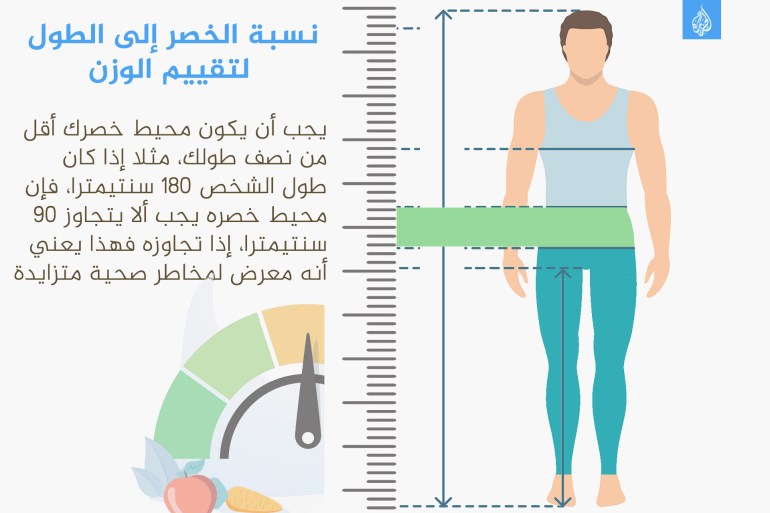The National Institute for Health and Care Excellence in the UK said people should make sure their waist measurements are less than half their height to avoid health problems.
The institute - known simply as "NICE" (NICE) said that adults with a body mass index (BMI) less than 35, should measure the ratio of waist to height, according to the newspaper The Independent (independent).
In a post on its website on the 8th of this month, the institute said that it encourages people to keep their waist measurements less than half their height, to reduce the risk of potential health problems, according to the recommendations contained in the institute's updated draft guidelines.
Using the waist-to-height ratio, along with BMI, could help provide a working estimate of central adiposity, the accumulation of fat around the abdomen, to help assess and predict health risks, such as type diabetes, the institute said. Second, hypertension or cardiovascular disease.
Before proceeding with the recommendations of the Institute, let us familiarize ourselves with the following two terms:
Body Mass Index (BMI)
Central Adiposity
body mass index
A number calculated using a person's height and weight, and is a reliable indicator in most cases for assessing overweight or underweight in most people.
BMI does not measure the amount or percentage of body fat.
How is body mass index calculated?
The BMI is calculated by dividing a person’s weight in kilograms by the square of his height in metres. For example, if a person’s height is 170 centimeters and weighs 75 kilograms, then 170 centimeters is converted to the meter unit, so it becomes 1.7, then divide the weight by its square:
75/2(1.7), in this case the result is 25.95.
How do you read BMI results?
For those 20 years of age or older, BMI is assessed using the following:
Below 18.5
: Weight loss, which can lead to a weakened immune system and increased risk of osteoporosis.
Also, being underweight may be associated with suffering from an eating disorder.
18.5 to 24.9
: The weight is normal, which means that there are no health risks associated with weight, while emphasizing that this does not mean that there are no health risks associated with other things.
25 to 29.9
: The person is overweight.
30 and over
: the person is obese.
central obesity
Central obesity is the accumulation of fat in the lower part of the torso around the abdominal area.
It is a product of both the subcutaneous fat and the visceral fat that surrounds the internal organs in the abdominal cavity.
High levels of central obesity have been associated with an increased risk of a number of diseases, including type 2 diabetes, high blood pressure, heart disease, and dementia.
It should be noted that central obesity is independent of BMI as an indicator of disease.
That is, a person may have a normal body mass index, but he has central obesity, and therefore has an increased risk of diseases.
This increased risk is thought to be due to the hormonal action of visceral fat, which actively secretes adipokines, most of which impair glucose tolerance.
Adipokines are molecules produced by adipose tissue that play roles in the body's metabolism, inflammation and obesity.
Examples include leptin, adiponectin, resistin, interleukin-6 and tissue necrosis factor (tissue necrosis facto).
The benefit of using the waist-to-height ratio
Returning to the National Institute for Health and Care Excellence, where Dr. Paul Crisp, Director of its Center for Guidance, said: "Our committee found that the clear benefit of using the waist-to-height ratio is that people can easily measure it for themselves, interpret results, and seek medical advice if they are at increased health risk." .
Steering committee member Professor Rachel Butterham, Consultant Obesity, Diabetes and Endocrinology, said: "Excess belly fat increases a person's risk of many life-limiting diseases, including type 2 diabetes and heart disease. Waist-to-height is a simple metric. Easy to use, it identifies people at increased health risk who would benefit from weight management support to improve their health."
Dr Nevedita Aswany, another member of the steering committee and a consultant pediatrician specializing in diabetes and weight management at Sheffield Children's Hospital, said: 'We know that excess belly fat increases the risk of diseases such as type 2 diabetes and non-alcoholic fatty liver. High blood pressure and cardiovascular disease, even in young children.
How do you apply the waist-to-height ratio?
For example, if a person is 180 centimeters tall, his waist circumference should not exceed 90 centimeters, and if it exceeds it, this means that he is exposed to increased health risks.
The advantage of this method is that it is easy, and does not require a balance or calculations.
Fasting and waist circumference
According to a study published in the Malaysian Journal of Nutrition, Ramadan fasting was associated with a lower waist circumference, which the researchers said may be due to the positive impact of Ramadan fasting on health.
The researchers said that the waist circumference, which represents abdominal adiposity - in both males and females - decreased significantly, after 3 weeks of fasting.
According to previous studies, a decrease in body weight was observed in the month of Ramadan, which is attributed to reasons including the effective use (burning) of body fat during fasting.
Studies have also found that overweight people lose more weight than normal or underweight people.

